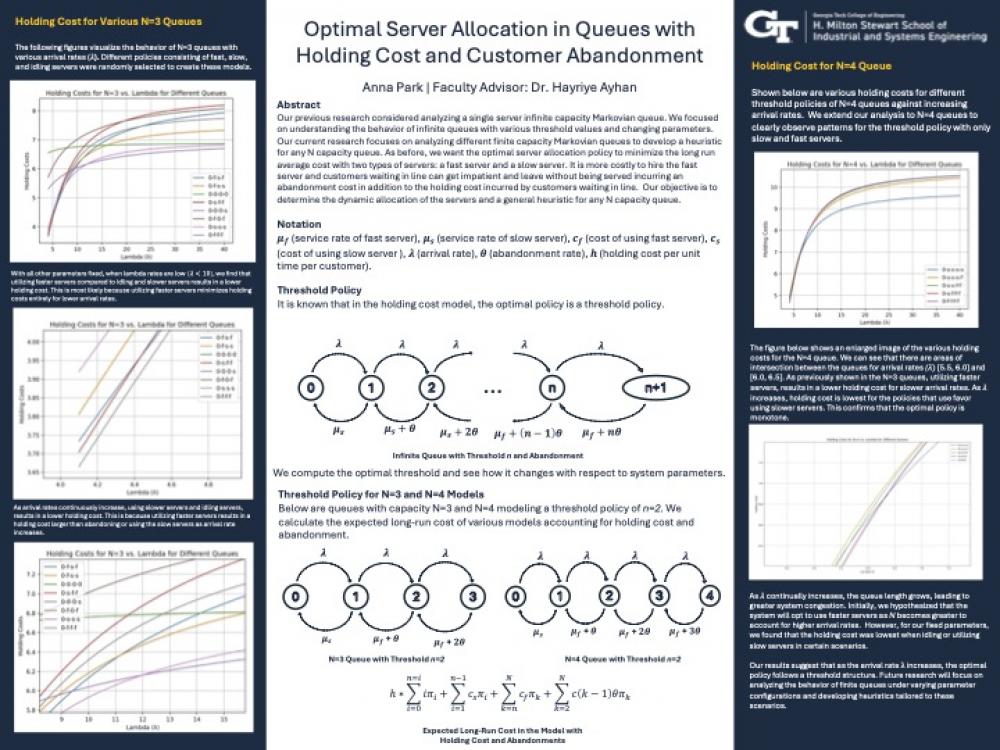Executive Summary:
Our research investigates optimal server allocation policies for finite capacity Markovian queues with two types of servers: fast and slow. Customers waiting in these queues incur holding costs, and those who abandon the queue impose abandonment costs. Our objective is to minimize the long-run average cost by determining the dynamic allocation of servers and developing a heuristic that generalizes for any NNN-capacity queue. Through the analysis of N=3 and N=4 queues under varying arrival rates (λ), we observed that the optimal server allocation policy follows a threshold structure, where the decision to use fast or slow servers depends on system congestion and arrival rate.
Research Motivation:
Queueing systems are prevalent in industries such as healthcare, retail, and transportation, where efficient resource allocation is critical to minimize operational costs and maintain customer satisfaction. Customers waiting in line incur holding costs, and those who abandon the queue add abandonment costs, presenting significant financial challenges. In practice, organizations must balance these costs with the higher expense of employing faster servers. While infinite queue models have been extensively studied, finite capacity queues better reflect real-world systems, where resource constraints and customer impatience are key factors. This research aims to fill the gap by exploring dynamic server allocation in finite queues and providing insights into cost-effective operational strategies.
Research Objective:
The objective of this research is to extend insights from infinite queue models to finite capacity systems and establish a general heuristic for any N-capacity queue.
Research Methodology:
We began by analyzing single-server infinite capacity Markovian queues to understand baseline behaviors and optimal policies under various parameters. We then transitioned to finite capacity queues, focusing on N=3 and N=4 systems. We evaluated different threshold policies, where server types (fast, slow, or idle) were dynamically selected based on queue length and arrival rates (λ). For each policy, we computed long-run average costs and identified patterns in server usage for various arrival rates. This process enabled us to test for the monotone structure of optimal policies.
Results:
Our analysis revealed that the optimal server allocation policy for finite capacity queues follows a threshold structure. For low arrival rates (λ<10), using fast servers consistently minimized holding costs by reducing queue lengths. However, as arrival rates increased, the cost of employing fast servers outweighed their benefits, leading to policies that favor slower servers or idling. In N=4 queues, holding cost patterns further confirmed the monotonicity of the optimal policy, with intersections occurring at arrival rate ranges λ∈[5.5, 6.0] and λ∈[6.0, 6.5]). Contrary to our initial hypothesis, for fixed parameters, utilizing slow servers or idling was more cost-effective than using fast servers in high-congestion scenarios. These findings provide insights into server allocation heuristics for finite queues and inform future research into parameter-specific optimizations.
Conclusions and Future Work:
Our study concludes that the optimal server allocation policy for finite capacity Markovian queues follows a threshold policy. For low arrival rates, faster servers minimize holding costs by reducing queue lengths, whereas for higher arrival rates, slower servers and idling prove more cost-effective due to higher costs associated with fast server utilization. These findings challenge the initial hypothesis that fast servers would be universally preferred in high-congestion scenarios, demonstrating the trade-offs between holding, abandonment, and server costs.
